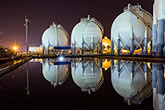Europe’s battle for gas market share
Published by Callum O'Reilly,
Senior Editor
Tanks and Terminals,
Europe’s need for imported gas is continuing to grow as its indigenous production declines. Wood Mackenzie believes that by 2035, Europe will need to import approximately 400 billion m3/yr of gas to meet demand, up from approximately 310 billion m3 in 2019.
While piped supplies from North Africa and Central Asia will provide about 50 billion m3 in 2035, the remaining 350 billion m3 will be sourced via a mix of piped Russian supply and LNG from both Russia and other producers.
With limited room to increase piped supplies from non-Russian gas producers, Russia will try to increase its presence in the European gas market, relying on its vast low-cost resource base and geographical proximity. But European gas market dynamics are changing, and it is getting harder for Russia to compete.
Kateryna Filippenko, Principal Analyst, Global Gas Supply, at Wood Mackenzie, said: “A wave of LNG has arrived. European LNG imports over the first five months of 2019 are up 50% year-on-year already. Net LNG imports into Europe will grow to 71 billion m3 in 2019 from 32 billion m3 in 2018.
“Flows will build into 2020 as US LNG start-ups continue, and we expect a record number of global LNG FIDs this year. These will underpin another wave of LNG in the mid-2020s, competing with Russian piped gas for market space.”
She added: “Russia will try to increase piped gas exports to Europe, but a mix of market, regulatory, political and corporate challenges will prevent new pipeline construction beyond Nord Stream 2 and TurkStream.”
Russia will retain ambitions to develop additional direct export routes into Europe as it maintains its strategic goal to bypass Ukraine. But it will need clear, unified support from Europe to embark on construction of new pipelines. Consequently, such new pipelines are unlikely.
“Infrastructure availability will be crucial to meet European demand,” she said. “Ukraine transit will be vital for stable and flexible supply into Europe in the near-term, particularly during seasonal demand peaks, maintenance periods and ramp up of new pipeline infrastructure. Ukraine transit will also help Russia increase piped supply post-2030.”
Russia is the largest supplier in the European gas supply mix. Its market share grew from 32% in 2015 to 37% in 2018 – and this is only piped gas. Gazprom intends to maintain this above 35% through to 2035, which could amount to about a half of Europe's overall gas imports.
But Russia is likely to aim higher. While Gazprom will be able to use its pipe network and Ukraine transit to increase exports further, ramping them up significantly will require new export capacity. Is LNG the way to go?
Ms Filippenko said: “Russia is likely to review its traditional, pipeline-based export model, and turn to LNG instead, at least for supplies to Europe. It will use LNG to grow its position in both the European and global market.”
Unlike piped gas, Russian LNG is less likely to be met with objections from Europe, given its flexibility. LNG offers an opportunity to respond quickly to price and market signals and access more markets, in and beyond Europe – particularly a premium Asian market. This is crucial amid the decarbonisation and diversification efforts in Europe.
Expansion of Russia's export capacity via LNG will be competitive on a cost basis against new pipes and competing global LNG projects.
The Russian government has big plans for its LNG industry – it aims to produce about 120 million to 140 million tpy of LNG by 2035, becoming one of the top three LNG exporters in the world with up to 20% market share. At present Russia’s share of the global LNG market is only 8%, but growing. Indeed, Russian LNG volumes into Europe for the first half of 2019 total 8 million t, making it the second largest supplier after Qatar.
Assuming that Russia maintains 60 billion m3 of Ukraine transit capacity and develops new LNG projects, the country’s export capacity available to Europe will grow by around 80 billion m3 between 2019 and 2035 – almost matching the increase in Europe’s import dependency.
Ms Filippenko said: “Opting for additional LNG rather than new pipeline projects will mean less direct tax revenue for the government and a potential revision of Russia’s traditional export approach. And more work needs to be done encouraging cooperation between the country’s leading oil and gas companies to support this.
“But LNG will ensure alignment with a range of governmental strategic goals and broaden Russia’s reach into new markets. It will allow to monetise giant gas reserves in an optimal way while derisking against European decarbonisation and diversification efforts.”
Read the article online at: https://www.tanksterminals.com/terminals/22072019/europes-battle-for-gas-market-share/
You might also like
SK Gas LNG terminal starts trial run
SK Gas's South Korea LNG Terminal in Ulsan has started its trial run in collaboration with the Korea National Oil Corp.

